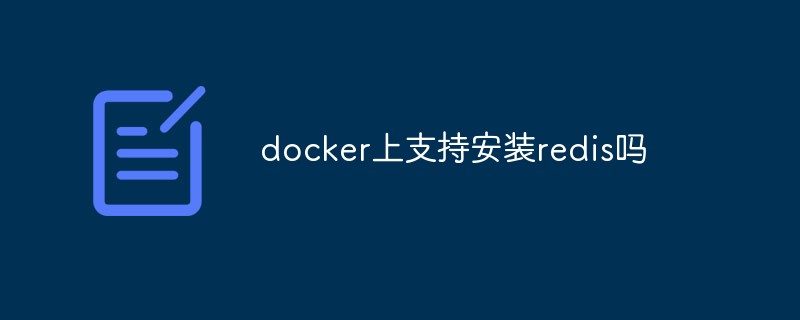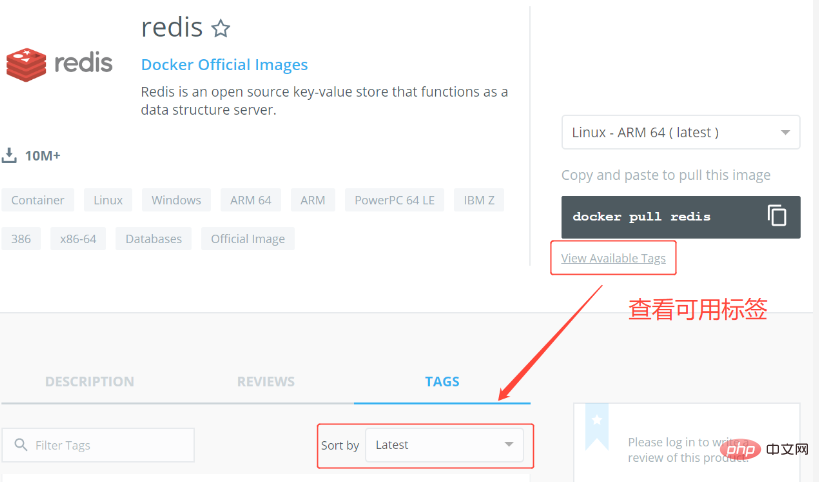Is installation of redis supported on docker?
Supports redis installation on docker. The installation method is: 1. Use "$ docker pull redis:latest" to install the redis image; 2. After the installation is completed, use the "$ docker run -itd --name redis -p port number redis" command to run the redis container; 3. You can Use "$ docker ps -a" to check whether the container is successfully installed.

The operating environment of this tutorial: linux7.3 system, docker version 19.03, Dell G3 computer.
Docker supports the installation of redis
After a normal installation of redis, redis can only be connected locally (127.0.0.1) by default and cannot be accessed remotely;
1. Install the redis image
Here we pull the official latest version of the image:
$ docker pull redis:latest

2. View the redis image
$ docker images
3. Run the container
After the installation is complete, we can use the following command to run the redis container:
$ docker run -itd --name redis -p 7001:6379 redis
The above command installs a container named redis, port The number is 7001;
4. Check that the container installation is successful
$ docker ps -a
Install redis under docker and support remote access
Normal After installing redis, redis can only be connected locally (127.0.0.1) by default and cannot be accessed remotely;
Use the following installation process to solve this problem;
1. Install the redis image (where latest is the mirror version, select the appropriate version according to the needs of the program)
$ docker pull redis:latest
2. Create two new folders, data and conf, in any location
$ mkdir -p /mydata/redis/data $ mkdir -p /mydata/redis/conf
3. Add the configuration file /mydata/redis /conf/redis.conf
Edit as follows:
//#bind 127.0.0.1 #允许远程连接 protected-mode no #启用保护模式 appendonly yes #持久化 requirepass 123456 #密码
Note:
Contents of the above file (redis.conf) There cannot be spaces between lines, otherwise after the new container is created, the container status will be stopped and cannot be started;
If a redis password is configured, in addition to the redis ip port is required during configuration In addition, you also need to configure the redis password;
4. Create a redis container and start it. The command is as follows:
$ docker run --name redis -p 6379:6379 -v /mydata/redis/data:/data -v /mydata/redis/conf/redis.conf:/etc/redis/redis.conf -d redis redis-server /etc/redis/redis.conf
The interpretation is as follows:
-
–name: Give the container a name
-p: Port mapping container: host
-v: Mount from Define configuration Custom configuration: Container internal configuration
-d: Run in the background
$ telnet 192.168.1.113 6379
docker video tutorial"
The above is the detailed content of Is installation of redis supported on docker?. For more information, please follow other related articles on the PHP Chinese website!

Hot AI Tools

Undresser.AI Undress
AI-powered app for creating realistic nude photos

AI Clothes Remover
Online AI tool for removing clothes from photos.

Undress AI Tool
Undress images for free

Clothoff.io
AI clothes remover

Video Face Swap
Swap faces in any video effortlessly with our completely free AI face swap tool!

Hot Article

Hot Tools

Notepad++7.3.1
Easy-to-use and free code editor

SublimeText3 Chinese version
Chinese version, very easy to use

Zend Studio 13.0.1
Powerful PHP integrated development environment

Dreamweaver CS6
Visual web development tools

SublimeText3 Mac version
God-level code editing software (SublimeText3)

Hot Topics
 1662
1662
 14
14
 1419
1419
 52
52
 1311
1311
 25
25
 1261
1261
 29
29
 1234
1234
 24
24
 How to exit the container by docker
Apr 15, 2025 pm 12:15 PM
How to exit the container by docker
Apr 15, 2025 pm 12:15 PM
Four ways to exit Docker container: Use Ctrl D in the container terminal Enter exit command in the container terminal Use docker stop <container_name> Command Use docker kill <container_name> command in the host terminal (force exit)
 How to copy files in docker to outside
Apr 15, 2025 pm 12:12 PM
How to copy files in docker to outside
Apr 15, 2025 pm 12:12 PM
Methods for copying files to external hosts in Docker: Use the docker cp command: Execute docker cp [Options] <Container Path> <Host Path>. Using data volumes: Create a directory on the host, and use the -v parameter to mount the directory into the container when creating the container to achieve bidirectional file synchronization.
 How to start containers by docker
Apr 15, 2025 pm 12:27 PM
How to start containers by docker
Apr 15, 2025 pm 12:27 PM
Docker container startup steps: Pull the container image: Run "docker pull [mirror name]". Create a container: Use "docker create [options] [mirror name] [commands and parameters]". Start the container: Execute "docker start [Container name or ID]". Check container status: Verify that the container is running with "docker ps".
 How to restart docker
Apr 15, 2025 pm 12:06 PM
How to restart docker
Apr 15, 2025 pm 12:06 PM
How to restart the Docker container: get the container ID (docker ps); stop the container (docker stop <container_id>); start the container (docker start <container_id>); verify that the restart is successful (docker ps). Other methods: Docker Compose (docker-compose restart) or Docker API (see Docker documentation).
 How to check the name of the docker container
Apr 15, 2025 pm 12:21 PM
How to check the name of the docker container
Apr 15, 2025 pm 12:21 PM
You can query the Docker container name by following the steps: List all containers (docker ps). Filter the container list (using the grep command). Gets the container name (located in the "NAMES" column).
 How to start mysql by docker
Apr 15, 2025 pm 12:09 PM
How to start mysql by docker
Apr 15, 2025 pm 12:09 PM
The process of starting MySQL in Docker consists of the following steps: Pull the MySQL image to create and start the container, set the root user password, and map the port verification connection Create the database and the user grants all permissions to the database
 How to create containers for docker
Apr 15, 2025 pm 12:18 PM
How to create containers for docker
Apr 15, 2025 pm 12:18 PM
Create a container in Docker: 1. Pull the image: docker pull [mirror name] 2. Create a container: docker run [Options] [mirror name] [Command] 3. Start the container: docker start [Container name]
 How to update the image of docker
Apr 15, 2025 pm 12:03 PM
How to update the image of docker
Apr 15, 2025 pm 12:03 PM
The steps to update a Docker image are as follows: Pull the latest image tag New image Delete the old image for a specific tag (optional) Restart the container (if needed)




